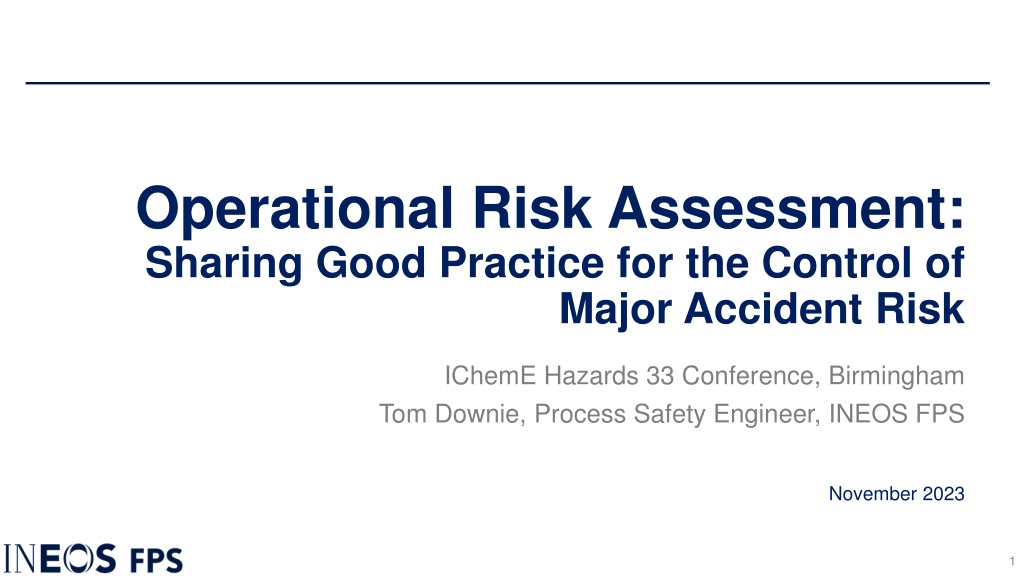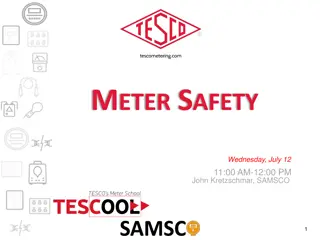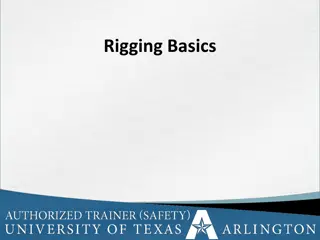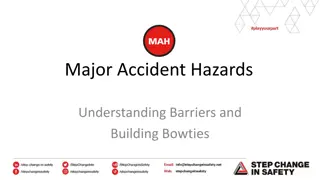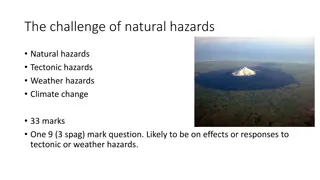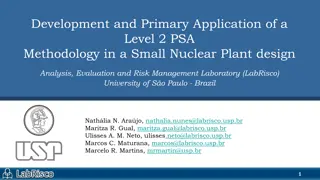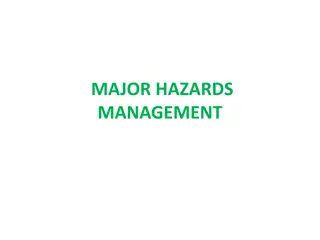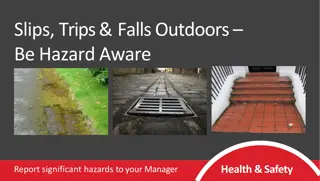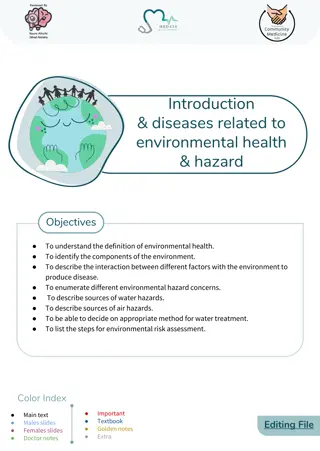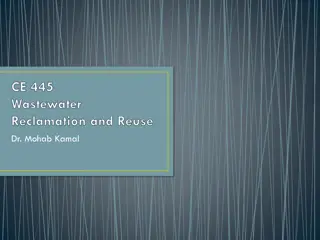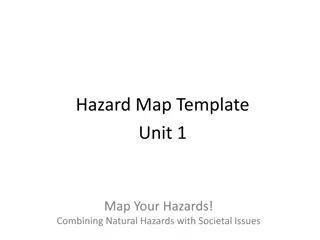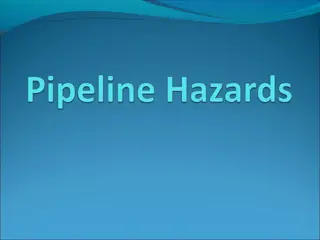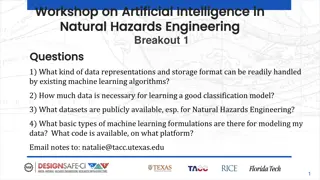Operational Risk Assessment for Major Accident Control: Insights from IChemE Hazards 33 Conference
This content provides valuable insights into the importance of Operational Risk Assessment (ORA) in managing major accident risks in high hazard industries. It covers the necessity of ORA, identifying changes, risk assessment, and key success factors. Real-life examples like the Buncefield Terminal explosion and the Watson Grinding incident highlight the critical need for proactive risk management to prevent catastrophic incidents. The case studies underscore the consequences of failing to identify and manage changes effectively. Overall, this presentation sheds light on best practices for operational risk assessment and the significance of ongoing vigilance in risk management.
Download Presentation

Please find below an Image/Link to download the presentation.
The content on the website is provided AS IS for your information and personal use only. It may not be sold, licensed, or shared on other websites without obtaining consent from the author. Download presentation by click this link. If you encounter any issues during the download, it is possible that the publisher has removed the file from their server.
E N D
Presentation Transcript
Operational Risk Assessment: Sharing Good Practice for the Control of Major Accident Risk IChemE Hazards 33 Conference, Birmingham Tom Downie, Process Safety Engineer, INEOS FPS November 2023 1
Introduction 1. Overview of INEOS FPS 2. Why is Operational Risk Assessment (ORA) required and what is it? 3. Identifying changes 4. Risk assessment 5. Managing risks 6. Summary of key factors for success 2
INEOS FPS INEOS FPS is an integrated oil and gas liquid transportation system operating in the Central North Sea The FPS 36 subsea pipeline extends from the Forties Charlie platform via the Forties Unity platform to a landfall at Cruden Bay on the North East Coast of Scotland - a distance of 169 kilometres The 36 FPS landline travels 209 kilometres south to the Kinneil Terminal at Grangemouth. The Kinneil Terminal processes the liquids into saleable gas, LPG and crude oil products for export or use at the Grangemouth Complex. 3
Why is Operational Risk Assessment Required? During the design of high hazard processes, relevant good practice and risk assessments are used to define the measures necessary to manage safety and environmental risks to a tolerable level During the lifetime of the process, abnormal conditions, defects, impairments and external factors may change the major accident risk Failure to identify and manage such changes as they emerge is a cause of serious incidents in high hazard industries 5
Challenges Challenge Major Incident Example Impact Buncefield Terminal, 2005 [1], UK. Major explosion and fire due to tank overfill. Critical factors included failure to identify and manage throughout changes at the facility and known defects with level monitoring systems Major Accident to Environment, Catastrophic asset damage Change identification Watson Grinding incident, 2020 [2], Texas. Major explosion due a propylene release inside a factory building. A critical factor was a failure to manage faults with a gas detection and shut-off system. Understanding the significance of changes 2 fatalities, 2 injuries, Catastrophic asset damage Prolonged and extensive environmental harm Fines and reparation > 200m Southern Water, 2019 [3], UK. Long term failure to manage equipment and monitoring equipment faults at the company s sewage treatment works leading to unpermitted sewage release into the environment Managing known changes 6
What is Operational Risk Assessment? It s a structured process for identifying, risk assessing and managing unplanned changes in major accident risk Goal is to normalise the discussion of change in major accident risk, and provide a simple process that can used to support asset operations ORA is common term in the oil and gas industry, but comparable process exist in other hazardous industries 7
Scope of the ORA Process At INEOS FPS the ORA process is primarily applied to unplanned changes in safety and environmental major accident risks discretion of plant manager to consider business and reputational risks Category Operation of equipment outside of normal operating envelope It is not used to manage acute immediate safety or environmental concerns INEOS Process Safety principles apply first and foremost Degradation of layers of protection, such as control systems, trip systems, alarms and relief systems Reduced equipment integrity INEOS Process Safety principle 9 - When in doubt the asset must always be taken to its safest state Impaired mitigation systems Any other system which is not meeting it s performance standard with potential safety or environment Planned changes are managed through a separate Management of Change Process 8
Interaction with complementary processes Process Description Operational Risk Assessment (ORA) Operational Risk Assessment Emerging unplanned changes to major accident risk Management of Change All changes (permanent or temporary) to plant and people Management of Change (MoC) Risk Management Process (RMP) Risk Management Process Complex long term risks with potential safety, environment, asset and reputations impacts 9
How are changed identified? Structured inspection, testing and maintenance activities Revealed failures i.e. plant stops working Technical oversight & review Monitoring of operating performance and long term trends Review of near misses and incidents Routine hazard study revalidations and other technical assessments There is no one solution to identifying change because the types of changes and the people who identify the change are highly variable 11
Foundational Elements for Change Identification 1. Accountability and responsibility for safe operation of the asset is clearly defined 24/7 - This ensures there is a clear reporting route when abnormal conditions become apparent - Fosters culture where ORAs are demanded rather than pushed on the people operating the asset 2. Adequate process safety information 3. Strong culture of safety observation and near miss reporting 12
Opportunities to Escalate Change Multiple opportunities are provided to catch potential changes Activity Strengths Primary direct report to Site Authority Site Authority is responsible for safe operation of the asset at all times and is responsible for identifying the needs for ORAs Simple and clear procedure when an obvious issue is identified any time of night or day Secondary Daily Operations and Maintenance Reviews All near misses, safety observations, work orders, operating envelopes and operational issues are reviewed daily and discussed as a team Provides an opportunity for a wider team to consider the impact of issues on major accident risk Tertiary Weekly and Monthly Process Safety Meetings All safety observations, near misses and emerging issues are reviewed weekly All near misses and KPIs are reviewed monthly Both meetings sponsored and attended by relevant leadership team personnel Weekly meeting provides an open forum to discuss changes and a parking lot is maintained of issues to monitor 13
Initial Assessment Initial assessment completed quickly and records an initial qualitative analysis of the risk and a decision on continued operation. If initial risk assessment shows risk is low priority it may be stopped at this stage or progressed to a full ORA with a more formal and detailed risk assessment The urgency of the ORA is agreed with the Site Manager (dependent on risk & complexity) and resource made available to support ORA risk assessment are supported by trained facilitators requires experience in a broad range of hazard study techniques and good knowledge of site process safety information 15
Detailed Risk Assessment Normal risk The team consider the hazard severity and likelihood for the system if it was operating as it was intended This may make use of existing hazard studies (HAZOPs, LOPA, Fire Hazard Analyses etc.) Facilitator determines appropriate risk assessment method typically semi qualitative LOPA but may be less or more detailed depending on the risk under consideration Abnormal Risk The team document what has changed and how it impacts the severity and / or likelihood The impact of any existing ORAs is considered 16 Mitigated Risk The team considers what else could we do , applying the hierarchy of control Additional measures are documented with an owner and details of how it will be applied The Abnormal Risk is re-evaluated with any credible mitigations in place (if any) Basis for Continued Operation The team consider why are we not shutting down? and describe the basis for continued operation, if any. The activities to remove the ORA are documented along with an expected duration.
Risk endorsement Senior managers visibly support the ORA process and are experienced in its application Risk Priority Endorsement Endorsement level by mitigated risk priority from 8x8 matrix which is imbedded in the FPS management system PURPLE CEO Significant changes to major accident risk typically require Operations Director endorsement BLUE Operations Director Permanent record of risk assessments and endorsements retained in the asset control of work software which includes an ORA module TURQUOISE Asset Manager WHITE Plant Manager Endorsed ORAs are communicated to operations and maintenance teams and remain accessible and visible at any time 17
Continuous review It is important to ensure that existing ORAs: Remain valid (i.e. the risk level remains correct) Are removed by the expected completion date (i.e. actions are resourced and completed) All existing ORAs receive a intensive ongoing review and monitoring This is both a strength and challenge with any ORA process 19
Continuous review Frequency Activities Shift operations team review all ORAs in place and review and sign any new ORAs as part of handover and daily meetings Daily Site Authority has to formally review and resign all existing ORAs ORAs and action plans reviewed as part of weekly process safety meeting Weekly Monthly All ORA are reviewed with Asset Manager 90 Days ORAs require formal re-review and endorsement 20
Summary 21
Summary Historical incidents show that unplanned change to major accident risk needs to be well managed, but that change takes a variety of forms. Indenting changes requires multi-layered and highly disciplined approach. ORAs are resource intensive to develop and manage. They must be applied strategically to major accident risks. Alternative change management tools must also be in place. Rapid initial risk assessments are an effective triage tool. ORA risk assessments require a normal, abnormal and mitigated risks to be defined. The focus must be on determining what more could be done to reduce the risk and ensure continued operation is not the default. Endorsement and engagement of senior leaders and the wider management team is crucial for success at INEOS FPS the there is strong pull from risk owners to use this process. ORAs require intensive review and management to ensure they remain valid and are resolved promptly. 22
